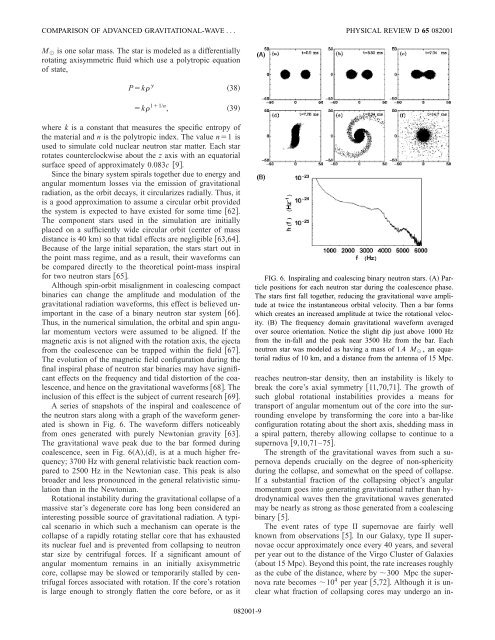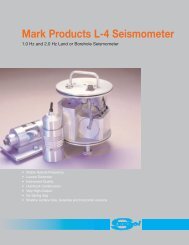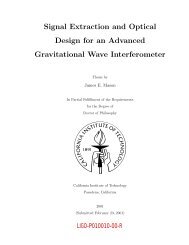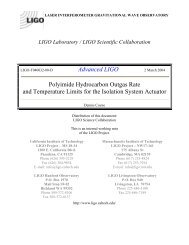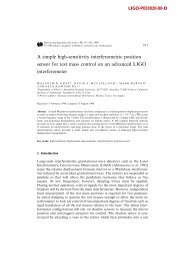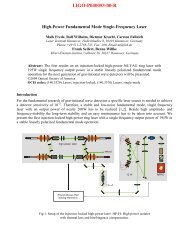LIGO-P030036-00-R - Ligo - Caltech
LIGO-P030036-00-R - Ligo - Caltech
LIGO-P030036-00-R - Ligo - Caltech
Create successful ePaper yourself
Turn your PDF publications into a flip-book with our unique Google optimized e-Paper software.
COMPARISON OF ADVANCED GRAVITATIONAL-WAVE ... PHYSICAL REVIEW D 65 082<strong>00</strong>1<br />
M is one solar mass. The star is modeled as a differentially<br />
rotating axisymmetric fluid which use a polytropic equation<br />
of state,<br />
Pk <br />
k 11/n ,<br />
38<br />
39<br />
where k is a constant that measures the specific entropy of<br />
the material and n is the polytropic index. The value n1 is<br />
used to simulate cold nuclear neutron star matter. Each star<br />
rotates counterclockwise about the z axis with an equatorial<br />
surface speed of approximately 0.083c 9.<br />
Since the binary system spirals together due to energy and<br />
angular momentum losses via the emission of gravitational<br />
radiation, as the orbit decays, it circularizes radially. Thus, it<br />
is a good approximation to assume a circular orbit provided<br />
the system is expected to have existed for some time 62.<br />
The component stars used in the simulation are initially<br />
placed on a sufficiently wide circular orbit center of mass<br />
distance is 40 km so that tidal effects are negligible 63,64.<br />
Because of the large initial separation, the stars start out in<br />
the point mass regime, and as a result, their waveforms can<br />
be compared directly to the theoretical point-mass inspiral<br />
for two neutron stars 65.<br />
Although spin-orbit misalignment in coalescing compact<br />
binaries can change the amplitude and modulation of the<br />
gravitational radiation waveforms, this effect is believed unimportant<br />
in the case of a binary neutron star system 66.<br />
Thus, in the numerical simulation, the orbital and spin angular<br />
momentum vectors were assumed to be aligned. If the<br />
magnetic axis is not aligned with the rotation axis, the ejecta<br />
from the coalescence can be trapped within the field 67.<br />
The evolution of the magnetic field configuration during the<br />
final inspiral phase of neutron star binaries may have significant<br />
effects on the frequency and tidal distortion of the coalescence,<br />
and hence on the gravitational waveforms 68. The<br />
inclusion of this effect is the subject of current research 69.<br />
A series of snapshots of the inspiral and coalescence of<br />
the neutron stars along with a graph of the waveform generated<br />
is shown in Fig. 6. The waveform differs noticeably<br />
from ones generated with purely Newtonian gravity 63.<br />
The gravitational wave peak due to the bar formed during<br />
coalescence, seen in Fig. 6A,d, is at a much higher frequency;<br />
37<strong>00</strong> Hz with general relativistic back reaction compared<br />
to 25<strong>00</strong> Hz in the Newtonian case. This peak is also<br />
broader and less pronounced in the general relativistic simulation<br />
than in the Newtonian.<br />
Rotational instability during the gravitational collapse of a<br />
massive star’s degenerate core has long been considered an<br />
interesting possible source of gravitational radiation. A typical<br />
scenario in which such a mechanism can operate is the<br />
collapse of a rapidly rotating stellar core that has exhausted<br />
its nuclear fuel and is prevented from collapsing to neutron<br />
star size by centrifugal forces. If a significant amount of<br />
angular momentum remains in an initially axisymmetric<br />
core, collapse may be slowed or temporarily stalled by centrifugal<br />
forces associated with rotation. If the core’s rotation<br />
is large enough to strongly flatten the core before, or as it<br />
FIG. 6. Inspiraling and coalescing binary neutron stars. A Particle<br />
positions for each neutron star during the coalescence phase.<br />
The stars first fall together, reducing the gravitational wave amplitude<br />
at twice the instantaneous orbital velocity. Then a bar forms<br />
which creates an increased amplitude at twice the rotational velocity.<br />
B The frequency domain gravitational waveform averaged<br />
over source orientation. Notice the slight dip just above 1<strong>00</strong>0 Hz<br />
from the in-fall and the peak near 35<strong>00</strong> Hz from the bar. Each<br />
neutron star was modeled as having a mass of 1.4 M , an equatorial<br />
radius of 10 km, and a distance from the antenna of 15 Mpc.<br />
reaches neutron-star density, then an instability is likely to<br />
break the core’s axial symmetry 11,70,71. The growth of<br />
such global rotational instabilities provides a means for<br />
transport of angular momentum out of the core into the surrounding<br />
envelope by transforming the core into a bar-like<br />
configuration rotating about the short axis, shedding mass in<br />
a spiral pattern, thereby allowing collapse to continue to a<br />
supernova 9,10,71–75.<br />
The strength of the gravitational waves from such a supernova<br />
depends crucially on the degree of non-sphericity<br />
during the collapse, and somewhat on the speed of collapse.<br />
If a substantial fraction of the collapsing object’s angular<br />
momentum goes into generating gravitational rather than hydrodynamical<br />
waves then the gravitational waves generated<br />
may be nearly as strong as those generated from a coalescing<br />
binary 5.<br />
The event rates of type II supernovae are fairly well<br />
known from observations 5. In our Galaxy, type II supernovae<br />
occur approximately once every 40 years, and several<br />
per year out to the distance of the Virgo Cluster of Galaxies<br />
about 15 Mpc. Beyond this point, the rate increases roughly<br />
as the cube of the distance, where by 3<strong>00</strong> Mpc the supernova<br />
rate becomes 10 4 per year 5,72. Although it is unclear<br />
what fraction of collapsing cores may undergo an in-<br />
082<strong>00</strong>1-9


